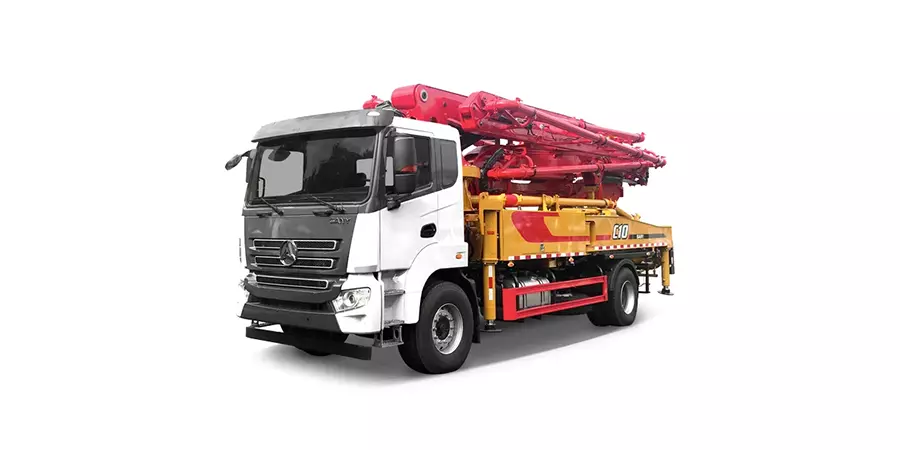Markets

Hydraulic Products Used in Pump Trucks
Pump trucks (commonly concrete pump trucks) rely on hydraulic systems to deliver precise control, high-pressure pumping, and mobility. Below is a detailed breakdown of key hydraulic components, their roles, and technical specifications:
1. Hydraulic Pumps
Function: Generate high-pressure hydraulic fluid to power the concrete pumping system and boom movement.
Types:
Pressure: 25–40 MPa.
Flow: 200–600 L/min.
Features: Load-sensing (LS) control for energy efficiency.
Axial Piston Pumps (e.g., Bosch Rexroth A11VO, Kawasaki K5V):
Gear Pumps: For auxiliary circuits (e.g., cooling, lubrication).
2. Hydraulic Motors
Function: Drive the concrete pump mechanism and boom rotation.
Types:
Torque: 15,000–50,000 Nm for pumping heavy concrete.
Radial Piston Motors (e.g., Danfoss 100 series):
Axial Piston Motors: For boom rotation (e.g., Parker F12).
3. Hydraulic Cylinders
Function: Control boom articulation, stabilizer legs, and pumping pistons.
Key Designs:
Telescopic Cylinders: Extend the boom to reach heights of 40–60 meters.
Double-Acting Cylinders: Precise control for boom positioning (±1° accuracy).
Durability: Hard-chromed rods, polyurethane seals, and anti-corrosion coatings.
4. Control Valves
Proportional Valves (e.g., HydraForce SV08):
Function: Adjust flow/pressure for smooth boom movement and pumping speed.
Response Time: <50 ms.
Load-Sensing Valves: Optimize energy use by matching pump output to demand.
Safety Valves: Pressure relief (set to 110% max pressure) and anti-drop valves for boom safety.
5. Hydraulic Power Unit (HPU)
Components:
Reservoir: 300–1,000 L capacity with air breathers (10 µm filtration).
Filters: Multi-stage filtration (βₙ≥1,000 @ 10 µm) to remove abrasive particles.
Coolers: Maintain oil temperature ≤60°C (air- or water-cooled).
Redundancy: Dual pumps for continuous operation during maintenance.
6. Auxiliary Systems
Accumulators (Bladder/Piston Type):
Absorb pressure spikes during sudden valve shifts.
Provide emergency power for boom retraction.
Swivel Joints:
Enable 360° boom rotation (pressure rating ≥35 MPa).
Multi-layered PTFE seals to prevent leaks.
7. Monitoring and Safety
Sensors:
Pressure Transducers: Monitor pump and boom pressures (e.g., Danfoss MBS 3000).
Temperature Sensors: Prevent overheating in continuous operation.
IoT Integration:
Remote diagnostics for predictive maintenance (e.g., pump wear alerts).
Key Brands
| Component | Leading Brands | Example Models |
|---|---|---|
| Pumps | Bosch Rexroth, Kawasaki | A11VO, K3V |
| Motors | Danfoss, Parker | 100 Series, F12 |
| Valves | Sun Hydraulics, HydraForce | CETOP 05, SV10 |
| Filters | Donaldson, Hydac | HFP Plus, DuoLine |
Maintenance Best Practices
Contamination Control:
Replace filters every 500 hours (ΔP ≥0.5 bar).
Use ISO VG 46/68 oil with NAS 8 cleanliness.
Seal Inspection:
Check cylinder rods monthly for scratches or leaks.
Cooling System:
Clean radiators monthly to prevent oil degradation.
Technological Trends
Electro-Hydraulic Hybrids:
Electric-driven pumps reduce fuel consumption by 30–40%.
Automated Boom Control:
PLC-guided path planning for precise concrete placement.
Smart Hydraulics:
IoT-enabled sensors predict component failure (e.g., pump wear).
Summary
Pump trucks depend on a sophisticated hydraulic system to achieve high-pressure concrete delivery and precise boom control. Core components include axial piston pumps, radial motors, telescopic cylinders, and smart valves, all engineered for durability in abrasive, high-load environments. Innovations like IoT integration and hybrid systems are enhancing efficiency, while rigorous maintenance ensures reliability in critical applications like high-rise construction and infrastructure projects.
